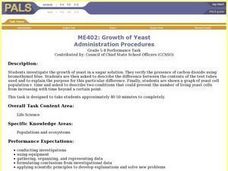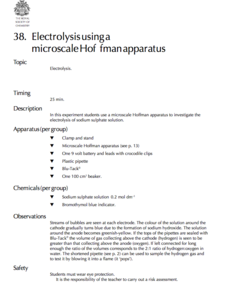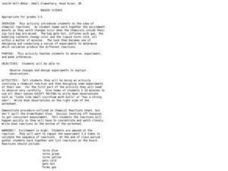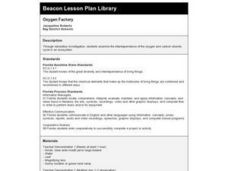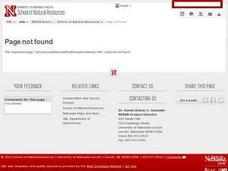Curated OER
ME402: Growth of Yeast
Students investigate the growth of yeast in a sugar solution. They verify the pressure of carbon dioxide using bromothymol blue. Students are asked to describe the difference between the contents of the test tubes used and to explain...
Curated OER
Every Breath You Take
Students study acids and bases and the uses of indicators. They interpret the actions of an indicator to conclude that bromothymol blue turns yellow in the presence of a weak acid.
Curated OER
Changing Planet: Ocean Acidification - the Chemistry is Less than Basic!
A video and laboratory investigation are highlights to this lesson on acidification of ocean water due to increased atmospheric carbon dioxide. Using bromothymol blue (BTB) as an indicator, pupils analyze the amount of carbon dioxide...
Curated OER
Carbon Dioxide - Sources and Sinks
Where does all of the carbon dioxide come from that is supposedly leading to climate change? Earth science pupils test animal, plant, and fossil fuels as sources in this investigation. Using an indicator, BTB, they are able to detect the...
Royal Society of Chemistry
Electrolysis Using a Microscale Hoffman Apparatus—Microscale Chemistry
Get big results out of a small-scale lab! Young chemists observe the electrolysis of sodium sulfate using a microscale experiment. A colorful indicator solution combined with the production of gas bubbles yields a variety of observations...
Curated OER
Where in the World is Carbon Dixoide?
Students conduct experiments designed to detect the presence of CO2 by using a BTB that changes color (blue to yellow) in the presence of CO2. First, students experiment with the CO2 from combining vinegar and baking soda. In part two,...
Curated OER
Acid-Base Indicators
The first two pages provide a chart to complete with results of a lab test using different solutions and indicators. The data analysis questions will help your students understand the concentrations of the solutions and how they affect...
Curated OER
Cycling of Matter and Energy
These twenty various types of questions related to the cycling of matter and energy require students to match each definition in column 1 with the correct vocabulary term from column 2. Then, students explain what is being demonstrated...
Curated OER
Everything Breathes!
Fifth graders test plants in the dark and in the light to see which grows better and produces more carbon dioxide. For this plants lesson plan, 5th graders also create ways for plants to go through photosynthesis that they can observe.
Exploratorium
Indicating Electrolysis
Sure, your learners know water is made up of two molecules, but watching them separate helps the class see the construction like never before. This resource provides directions on how to build a simple electrolysis device using a...
Cornell University
Build a Fuel Cell
Discover the connection between redox reactions and fuel cells. Collaborative groups build a Hoffmann Apparatus that demonstrates the electrolysis of water and then convert their models into a fuel cell. They use their fuel cells to...
Curated OER
The Science of Respiration and Blood Circulation
Fifth graders study how respiration and circulation are connected. For this respiratory lesson students complete several activities to better understand heart rate and carbon dioxide in the body.
Curated OER
Acid-base Indicators
There is a chart to complete with results of the titrations for the 14 different pH indicators. There are also nine questions for data analysis, and then four problems requiring equations, molarities, and pH values.
Curated OER
Make Acid Rain
Young scholars create models of the earth's atmosphere to explore how gases that are dissolved in water can eventually create acid rain. After conducting a series of experiments within their models of the earth's atmosphere, students...
Curated OER
Acids, Bases and Indicators
Students investigate the pH of various solutions with indicators. In this acids, bases and indicators lesson plan, students use a variety of indicators to test solutions for their pH. Students determine which indicators are the best to...
Curated OER
How about a Little Give and Take?
Learners design a closed system to test the relationships between plants and animals. They monitor abiotic fluctuations within this living system by using a chemical test kit. They observe how living organisms respond to fluctuations in...
Curated OER
Baggie Science
Students observe and describe a chemical reaction. In this chemistry lesson plan, students record observations of the materials they will be using, then follow a written procedure to perform the experiment in a baggie and record their...
Curated OER
Oxygen Factory
Fourth graders examine the interdependence of the oxygen and carbon dioxide cycle in an ecosystem through a laboratory investigation. After a lecture/demo, 4th graders complete the lab in groups.
Curated OER
Earth's Atmosphere and Temperature
Students explore the layers of earth's atmosphere and conduct an experiment to identify carbon dioxide. They construct models using styrofoam to represent molecules in the atmosphere's layers. To discover how sunlight efffects...
Curated OER
Separation of Mixtures and Compounds For K Through 12
Learners explore mixtures and compounds. For this lesson, students do an experiment to distinguish between mixtures and compounds. Learners complete ten different phases of the experiment testing many different substances. Students will...


